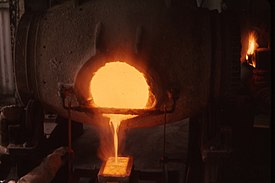 Global Information
Global InformationMetallurgy information


Metallurgy is a domain of materials science and engineering that studies the physical and chemical behavior of metallic elements, their inter-metallic compounds, and their mixtures, which are known as alloys.
Metallurgy encompasses both the science and the technology of metals, including the production of metals and the engineering of metal components used in products for both consumers and manufacturers. Metallurgy is distinct from the craft of metalworking. Metalworking relies on metallurgy in a similar manner to how medicine relies on medical science for technical advancement. A specialist practitioner of metallurgy is known as a metallurgist.
The science of metallurgy is further subdivided into two broad categories: chemical metallurgy and physical metallurgy. Chemical metallurgy is chiefly concerned with the reduction and oxidation of metals, and the chemical performance of metals. Subjects of study in chemical metallurgy include mineral processing, the extraction of metals, thermodynamics, electrochemistry, and chemical degradation (corrosion).[1] In contrast, physical metallurgy focuses on the mechanical properties of metals, the physical properties of metals, and the physical performance of metals. Topics studied in physical metallurgy include crystallography, material characterization, mechanical metallurgy, phase transformations, and failure mechanisms.[2]
Historically, metallurgy has predominately focused on the production of metals. Metal production begins with the processing of ores to extract the metal, and includes the mixture of metals to make alloys. Metal alloys are often a blend of at least two different metallic elements. However, non-metallic elements are often added to alloys in order to achieve properties suitable for an application. The study of metal production is subdivided into ferrous metallurgy (also known as black metallurgy) and non-ferrous metallurgy, also known as colored metallurgy.
Ferrous metallurgy involves processes and alloys based on iron, while non-ferrous metallurgy involves processes and alloys based on other metals. The production of ferrous metals accounts for 95% of world metal production.[3]
Modern metallurgists work in both emerging and traditional areas as part of an interdisciplinary team alongside material scientists and other engineers. Some traditional areas include mineral processing, metal production, heat treatment, failure analysis, and the joining of metals (including welding, brazing, and soldering). Emerging areas for metallurgists include nanotechnology, superconductors, composites, biomedical materials, electronic materials (semiconductors) and surface engineering. Many applications, practices, and devices associated or involved in metallurgy were established in ancient India and China, such as the innovation of the wootz steel , bronze, blast furnace, cast iron, hydraulic-powered trip hammers, and double acting piston bellows.[4][5]
- ^ Moore, John Jeremy; Boyce, E. A. (1990). Chemical Metallurgy. doi:10.1016/c2013-0-00969-3. ISBN 978-0408053693.
- ^ Raghavan, V (2015). Physical Metallurgy: Principles and Practice (3rd ed.). PHI Learning. ISBN 978-8120351707. Archived from the original on 24 June 2021. Retrieved 20 September 2020.
- ^ "Металлургия" Archived 18 January 2015 at the Wayback Machine. in The Great Soviet Encyclopedia. 1979.
- ^ R. F. Tylecote (1992) A History of Metallurgy ISBN 0901462888
- ^ Robert K.G. Temple (2007). The Genius of China: 3,000 Years of Science, Discovery, and Invention (3rd ed.). London: André Deutsch. pp. 44–56. ISBN 978-0233002026.